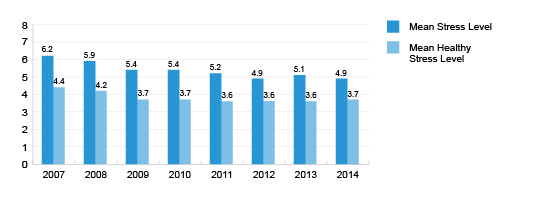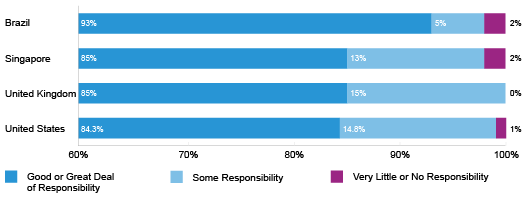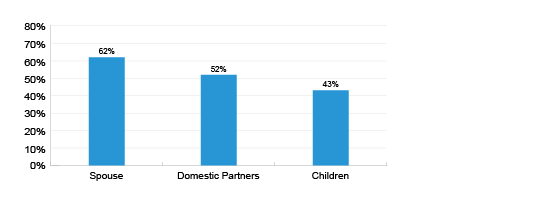Let’s face it: stress is a part of most people’s lives. Some level of pressure is normal, and serves a positive purpose for motivating our daily activities. But when the strain becomes unmanageable, it can have physical and emotional effects that challenge not only individuals and their families, but also their employers. In fact, highly stressed workers cost employers an average of $413 more per year1 in time away from work than their less-stressed counterparts.
It’s likely that most people reading this post are under some level of stress. Although the American Psychological Association’s most recent Stress in AmericaTM survey found that stress levels are at a 4.9 on a 10-point scale – down from 5.1 in 2013 and 6.2 in 2007 – Americans still say they experience more stress than what they consider healthy, and 42 percent of respondents say they’re not doing enough to manage their stress.
Average Stress Levels
Many studies connect the cause of stress to workplace-related issues like job security, work-life balance and co-worker issues. But we’re not paying nearly enough attention to the cost of stress in the workplace. A recent study found that employees with high stress levels account for $1,062 in excess medical claims and $284 in excess pharmacy claims annually2. And approximately 40 percent of employee turnover is attributable to stress3.
[ctt title=»While work does not cause all stress, all stress can impact an employee’s work, bringing down their productivity.» tweet=»How can employers help their employees manage #stress levels? Read more in a @XeroxHRInsights blog post http://ctt.ec/bA1LS+» coverup=»bA1LS»]Employers are aware of these issues, but they need to look at stress and mental well-being beyond the framework of healthcare costs and churn. Stress (both work-related and non-work-related) and related issues of anxiety, depression, overwork and burnout can limit a person’s ability to make good decisions, cope with daily challenges, manage relationships, realize their full potential, and make a productive and fruitful contribution to their work team, family and community. It can also put their safety and the safety of others at risk. While work does not cause all stress, all stress can impact an employee’s work, bringing down their productivity, engagement and motivation levels. That, in turn, affects the employer’s bottom line.
Top 4 Sources of Stress
So what’s an employer to do? How can employers help their employees manage stress levels while successfully managing the bottom line?
Unfortunately, there’s no single magic-bullet solution, but it’s encouraging to know that 84 percent of employers believe it’s their responsibility to provide a working environment that promotes mental well-being, according to our recent Mental Well-being survey. In fact, there are many programs that focus on stress triggers, such as finances and health, which employers could implement to help employees mitigate some of the pressures in their life.
For instance, some financially-driven stress can be addressed using a motivational tool, like SavIncentTM, to help promote and increase employees’ financial wellness. The tool combines an innovative defined contribution plan design with a rewards program tied to a wide range of employee financial activities. As an example, the program provides financial rewards – additional contributions made directly to their retirement savings plan – to employees who enroll in a 401(k) plan, meet with a financial advisor, establish a will, or increase their credit score.
How much responsibility should employers have to provide a working environment that supports or promotes mental well-being?
Wellness programs are also very popular – they not only help reduce sick leave and presenteeism, but also improve morale and engagement, and help employers manage healthcare costs. They key is to ensure that a wellness program addresses stress and mental well-being as well as physical wellness. A 2013 study estimated that high-risk factors for stress accounted for approximately 7.9 percent of total healthcare expenditures, the largest incremental expenditures of 11 risk categories including body weight and tobacco use4. Some companies take these programs one step further, offering them to employees’ spouses, domestic partners and children, to help address stress and other lifestyle-related factors in the home. According to our sixth annual Working Well survey, 62 percent of programs include spouses, 52 percent include domestic partners and 43 percent include children.
Percentage of companies making spouses, domestic partners and children eligible for health promotion and wellness programs
It’s impossible to completely eliminate stress in the workforce, but through compelling programs that target stressors such as finance and health, employees can learn to better manage their mental health and become better able to engage in their work. In return, employers can see increased productivity, reduced healthcare costs, and a happier, healthier, higher-performing workforce.
Bite size data points to support the post:
- 84% of employers believe they have a good or great deal of responsibility to provide a working environment that promotes mental well-being.
- Source: our Promoting Mental Well-being survey, 2015
- More than one-third of employers rate the stress level within their organization as “high or very high.”
- Source: our Promoting Mental Well-being survey, 2015
- 87% of employers see employee performance as the most important reason to address work-related stress and poor mental well-being. Employee engagement, productivity and motivation fall closely behind.
- Source: our Promoting Mental Well-being survey, 2015
- High stress individuals cost an average of $413 more per year in time away from work than their less-stressed counterparts.
- Source: Journal of Comparative Neurology and Psychology
- Employees with high stress have $1,062 in excess medical claims and $284 in excess pharmacy claims annually.
- Source: Staying@Work Survey Report, 2012
- Approximately 40% of employee turnover is attributable to stress
- Source: Journal of the American Medical Association
- A 2013 study estimated that high-risk status for stress accounted for approximately 7.9% of total health care expenditures, the largest incremental expenditures of 11 risk categories including body weight and tobacco use.
- Source: Fortune Magazine, 2013
End notes



